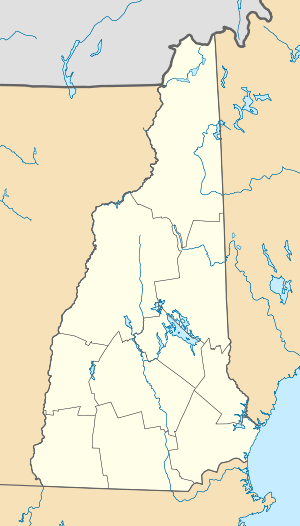The Congregational Church in Exeter
|
The Congregational Church in Exeter | |
|
The Congregational Church in Exeter, UCC | |
  | |
| Location | 21 Front St., Exeter, New Hampshire, United States |
|---|---|
| Coordinates | 42°58′50″N 70°56′51″W / 42.98056°N 70.94750°WCoordinates: 42°58′50″N 70°56′51″W / 42.98056°N 70.94750°W |
| Built | 1798 |
| Architect | Clifford,Ebenezer; Johnson,Bradbury |
| Part of | Front Street Historic District (#73000270) |
| NRHP Reference # | 71000052[1] |
| Significant dates | |
| Added to NRHP | September 10, 1971 |
| Designated CP | July 5, 1973 |
The Congregational Church in Exeter was gathered in 1638 by Rev. John Wheelwright.
The current building, located at 21 Front Street in Exeter, New Hampshire, was built in 1798 and can seat 400. It is the fifth meeting house built by the congregation, was designed by Ebenezer Clifford, a local builder, and has a number of distinctive features. Its hip roof is believed to be the earliest such roof built on a church in the state, and its only entrances were through the projecting entrance bay (unlike earlier traditional meeting houses, which had entrances on three sides). In 1838 the interior of the building was remodeled, removing box pews, and converting the gallery to a full second floor. The sanctuary was then on the upper level, with meeting rooms and other facilities below. An addition was made to the rear of the church in 1930, giving it a more square footprint.[2]
The building was listed on the National Register of Historic Places in 1971.[1] It is included in the Front Street Historic District. Notable items inside the church include the pew in which Abraham Lincoln sat when he came to visit his son at the nearby Phillips Exeter Academy, a portrait of Lincoln, and a portrait of Rev. Wheelwright. The church sanctuary organ is an Aeolian-Skinner with three manuals and 20 ranks of pipes, dedicated in 1951.[3] There is a small, working memorial garden at the side of the church, in which are also buried town fathers Folsom and Gilman.[4]
In literature, the church building figures in John Irving's 1989 novel A Prayer for Owen Meany.[5]
The current congregation is a merger of the former First Parish and Second Parish of Exeter. Second Parish split from First Parish in the 1700s, and then reunited in the early 20th century. Today, the church has an active membership, a Sunday School program, a food pantry, and a community garden.[3] The church is also involved in a local collaboration on a free lecture series, that brings in speakers on current topics; past speakers have included environmentalist Bill McKibben and writer James Carroll.[6]
The congregation is a member of the United Church of Christ, and has been an Open and Affirming (actively welcoming LGBTQ people) congregation since 1996.
See also
References
- 1 2 National Park Service (2009-03-13). "National Register Information System". National Register of Historic Places. National Park Service.
- ↑ "NRHP nomination for First Church" (PDF). National Park Service. Retrieved 2014-06-13.
- 1 2 "church website". Retrieved 4 May 2012.
- ↑ "Folsom Society website". Retrieved 4 May 2012.
- ↑ "Spark Notes website". Retrieved 4 May 2012.
- ↑ "Water Street Bookstore website". Retrieved 4 May 2012.
External links
- The Congregational Church in Exeter, UCC - official site

